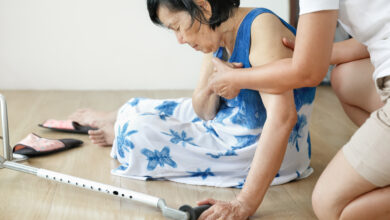Sizing up an epidemic

As childhood obesity affects more and more families, nurses must prepare to help parents address the problem.
Australian children are dying from obesity and, according to a Sydney nurse specialist, it’s impossible to know the extent of the problem.
For 2011–12, the Australian Bureau of Statistics reported about 25 per cent of Australian children were either overweight or obese, according to measured body mass index.
However, it is the phrase “measured BMI” that has Joanne Henderson, clinical nurse consultant for weight services at the Children’s Hospital at Westmead, in Sydney, concerned.
Henderson, who describes herself as an old-school, hospital-trained nurse, believes we have moved away from taking children’s heights as basic practice in the health setting. And since both height and weight are necessary to calculate BMI, she sees this as a problem.
“Because heights are not being recorded, probably only about 40 to 50 per cent of children get [their measured BMI] done in a hospital,” she says. “When you have those sorts of numbers not showing up on the records, the actual size of the [childhood] obesity crisis is not visible.”
As one of only about six nurses who work specifically with childhood obesity in Australia and New Zealand, Henderson says until the recording of heights and weights becomes more common practice, we will not be able to monitor this growing epidemic.
It is common for her to see kids who have never had a height and weight done. Even children who are visibly obese, she says, rarely have obesity as a comorbidity written into their notes.
“I treat kids who have been into emergency five, six, seven, eight times in multiple facilities and haven’t had a height and weight done,” she says.
“These kids, for example, are eight-year-olds who are 80 kilos and it hasn’t even been mentioned in their notes that they’re obese. So how would anyone know how big the issue is if it’s not there?”
Over the past few years, there have been a couple of well-publicised cases of obesity in children, including one where a seven-year-old who weighed nearly 50 kilograms died from related complications.
This type of case is extreme; however, Henderson confirms patient numbers are increasing – and the patients are getting bigger.
She categorises patients on a one to three scale, one being for kids with multiple co-morbidities who need to be brought in straightaway, up to three, where they are in a bad way but not requiring urgent attention.
“I’ve been doing this job for nine years now, and back [at the start] I would have probably had about 4 per cent of my clientele in the [highest] range,” Henderson says. “Now I have 90 per cent, and my client base has probably quadrupled.”
Monash University statistics show that Aboriginal and Torres Strait Islander Australians are 1.9 times as likely as non-Indigenous Australians to be obese and they have the fourth-highest rate of Type 2 diabetes among all the world’s populations. Prevalence is also higher for Indigenous children.
A future prevalence report from 2008 states that if rates of obesity in children keep climbing without intervention, by 2025 about one-third of youths aged 5 to 19 will be overweight or obese.
So what can paediatric nurses do to play a role in helping prevent this epidemic that has been labelled Australia’s single biggest health threat?
Fran Stoddart, nurse educator, paediatrics (tertiary education services) at the Australian College of Nursing, says the main role for nurses is to provide education to parents in a way that doesn’t label them and their children as obese. There is a stigma associated with childhood obesity, both for the patient and the parents, and Stoddart says it is up to nurses to dispel myths by providing good education.
“I think parents often already know their child is overweight,” she says. “They have very strong feelings of guilt about it, so they are very sensitive about their child being targeted or classified as obese or morbidly obese.”
Practical advice for parents is vital, as well as visual education, which can be effective in targeting people from non-English-speaking backgrounds. However, Henderson believes sparking the initial conversation with parents is one of the main challenges for nurses, especially for those who have a weight problem of their own.
She advises treating the situation as if you were taking a patient’s blood pressure.
“If you see that somebody’s blood pressure is abnormally high, you would routinely say, ‘I’d like you to rest for a little bit, as your blood pressure is a bit high, and I’ll get someone to check it later.’ Even if the nurse has high blood pressure, they wouldn’t have a problem addressing it with somebody.
“The same thing needs to happen with children who are above a healthy weight.If a child’s growth and development is abnormal – which can be above or below a healthy weight – suggest to the family they talk to their local doctor about it.”
Another key area for nurses working in paediatrics is that of advocacy. Nurses are passionate about dealing with childhood obesity, but are hesitant when they don’t feel supported.
“Nurses don’t want to be talking about healthy eating options with parents when the hospital or healthcare centre is providing the opposite for the kids,” Stoddart says.
In 2010, the federal government commissioned the National Health and Research Council to develop a set of guidelines for health professionals to help with the management of people with obesity.
The guidelines, Clinical Practice Guidelines for the Management of Overweight and Obesity in Adults, Adolescents and Children in Australia, state that most children and adolescents who are overweight or obese are identified through primary healthcare.
In line with this, Stoddart believes there is a great chance for nurses working in child and family health to be part of the fight against childhood obesity.
“Child and family health nurses have the opportunity to talk to parents in a situation where they’re more relaxed, not in a situation where a child has been admitted for something,” Stoddart says. “They can follow them up more easily because they’re independent practitioners, so I think there’s a huge opportunity for specialist positions in the child and family health sector.”
Email: [email protected]




